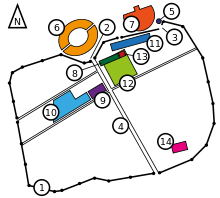Segobriga
 Shown within Spain | |
| Location | Spain |
|---|---|
| Region | Castile–La Mancha |
| Coordinates | 39°53′06″N 2°48′47″W / 39.885°N 2.813°W |
Segóbriga was an important Roman city, and is today an impressive site located on a hill near the present town of Saelices. Archaeology has revealed the remains of important buildings which have been conserved and are visible today in the Archaeological Park.
History

The first mention we have of Segóbriga is a brief reference by the Greek geographer Strabo,[1] that Quintus Caecilius Metellus Pius fought in the Wars of Sertorius, in the Celtiberian region around Bílbilis and Segóbriga. This ancient area of the Olcade tribe was thus razed in these wars and replaced by Roman Segóbriga.
Writing in the first century BC, Sextus Julius Frontinus mentions Segóbriga twice.[2] He describes the attack by the Lusitanian Viriatus against Segóbriga (146 BC) which was allied to Rome:
1) "Viriatus, arranging his troops in ambush, sent a few to steal cattle from the Segobrigenses; they like to go in large numbers to punish, they ran, fleeing ..."
2) "Viriatus turned back and ran into unsuspecting Segobrigenses, when most were busy at their sacrifice".
Pliny[3] mentions the exploitation of lapis specularis, a variety of translucent gypsum much appreciated at the time for the manufacture of window glass and an important part of the Segbriga economy. This material was mined in "100,000 places around Segóbriga" and Pliny assures us that "the most translucent of this stone is obtained near the city of Segóbriga and extracted from deep wells".
After the Roman conquest in the Celtiberian Wars of the early second century BC, Segobriga must have been a hill fort or Celtiberian town. After the wars of Sertorius, it became the centre of its part of the plateau and controlled a large territory.
In the time of Augustus around the year 12BC, it ceased to be a stipendiary city which paid tribute to Rome, and became a Municipium, governed by Roman citizens of important status, which led to an economic boom. A program of monumental building was completed in the Flavian period of the 80's AD, and public buildings and the city wall can be admired today. The city was an important centre of communications. At this time the city was allowed to issue currency in its mint.
Archaeology indicates that in the third century the wealthy elite were still living in the city, but in the fourth century they abandoned its attractions, evidence of inexorable decline and its gradual conversion into a rural centre.
Visible Buildings
The city was surrounded by a wall of 1300m length with several gates, the main gate directly accessing the Forum.
The Forum was rectangular and surrounded by a colonnade supported by large columns. It was the most important social and political centre of Segóbriga.



See also
References
Coordinates: 39°53′06″N 2°48′47″W / 39.885°N 2.813°W